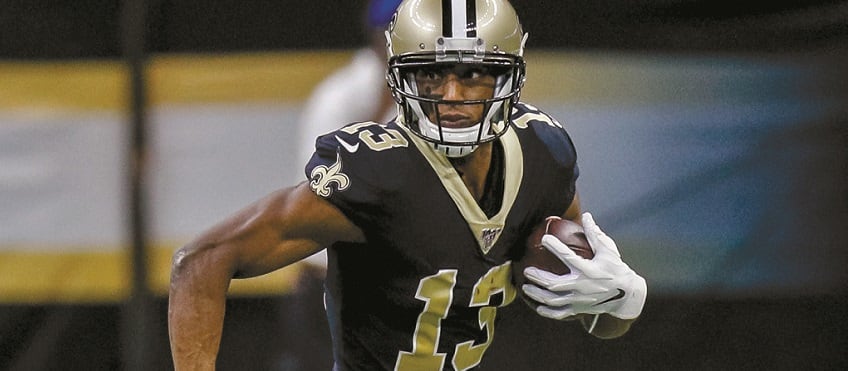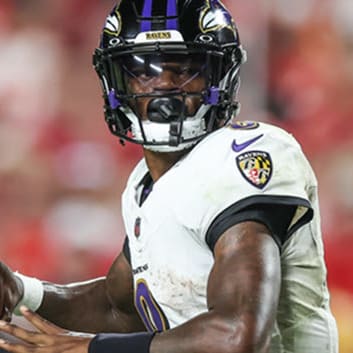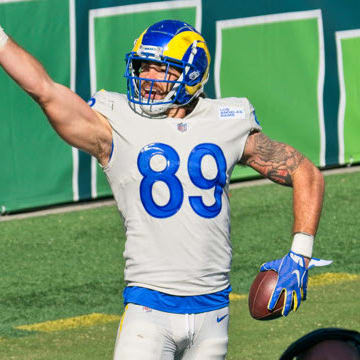This article is part of our NFL Observations series.
Every year, the staff of RotoWire gathers in Las Vegas during the baseball All-Star break, and part of that super-serious industry conference is the drafts for the Vegas League, an early 12-team format that allows wags like us to get a jump on picking up shares of our favorite sleepers before NFL ADPs have really become set. Every year until 2020, that is. With travel plans a no-go, the league instead got converted into a slow draft and thrown open to the entire staff, not just the people able to make it to Vegas. As a result, we ended up with five 'conferences' of 12 teams each, all running their drafts at the same time via email, and that provided an opportunity to take a look in real time at the state of the player pool heading into the final weekend before Week 1.
The rules are fairly basic: 12 teams per draft, QB/RB/RB/WR/WR/WR/TE/RB-WR-TE Flex/DST/team K, six bench slots, standard (non-PPR) scoring. Our regular season will be 13 weeks, with individual conference playoffs in Week 14-15 and then a five-way Super Bowl between the conference champs in Week 16. You didn't have to fill every starting spot in the draft, so some GMs elected to skip taking a kicker and instead pick up another skill position lottery ticket, but that's a play that tends to work better the earlier the draft is held. With only a week or so before our first FAAB period, most teams played it safe and grabbed someone to fill every spot.
Fortunately for the purpose of this overview, there weren't any major news items that hit in the middle of the proceedings, something which can make a slow draft an exercise in luck on occasion. The biggest shocker was the Jaguars cutting Leonard Fournette loose Monday, but three of the five conferences had already completed their entire drafts before that news crossed the wire, leaving Ryquell Armstead as a late-round windfall for only a couple of GMs.
Just to get it out of the way, here's the roster my team, I Left My Waller In El Cortez, came away with in the Aria conference:
QB: Kyler Murray, Joe Burrow
RB: Clyde Edwards-Helaire, Cam Akers, Devin Singletary, Latavius Murray, Joshua Kelley
WR: DeAndre Hopkins, Tyler Boyd, Marvin Jones, Mecole Hardman, Darius Slayton, Parris Campbell
TE: T.J. Hockenson
DST: Broncos
Team K: Chiefs
Now let's take a look at how the drafts went, both from a wider strategy perspective and at a more granular level position by position.
Overall Strategy
Remarkably, none of the 60 GMs involved in the league decided to go zero RB. Well, at least it was remarkable to me, as I'd fully intended to try it while picking 10th in my conference. With a slot near the end of the round, I expected to be able to double-tap WRs, or grab an elite WR and elite TE, to get the plan rolling. That idea immediately got tossed in the bin when Clyde Edwards-Helaire fell into my lap, the latest he lasted in any of the five drafts. The closest anyone came to a true zero-RB approach was Neil Parker, who went WR-QB-WR out of the 12 slot before grabbing Raheem Mostert at 4.1 and then two more RBs at the 5/6 turn (Cam Akers and Ronald Jones). In fact, only four GMs in total managed to get out of the first two rounds without a running back on their roster.
By contrast, 17 GMs went the traditional RB/RB with their first two picks, and one even went RB/RB/RB to begin their draft (Logan Larson, who scooped up CEH, Kenyan Drake and James Conner from the six slot.)
Waiting on QBs remains a popular choice as well. Even with two elite options in Patrick Mahomes and Lamar Jackson at the top of the pool, and a group of four mobile studs right behind them in Kyler Murray, Dak Prescott, Deshaun Watson and Russell Wilson, teams that didn't get one of those six remained patient. Nineteen GMs, nearly one-third of the teams in the league, didn't select their first QB until the ninth round or later.
Quarterback
Mahomes and Jackson predictably went 1-2 among QBs in all five drafts, and in that order. Mahomes went at 1.11 three times, and 2.1 once – the latest he came off the board as the first QB was 2.10. Jackson went within six picks of him four times, as GMs that wanted to secure an elite quarterback felt the pressure to pounce, but he lasted until 2.12 in the fifth draft when Mahomes went at 1.11.
The Tier II Crew
The four Tier II guys were the next four off the board in four of the five drafts, with Tom Brady spoiling the party as the QB4 in the fifth. When they came off the board followed wildly different schedules, though – the earliest any of them was picked was at 3.9, but the latest the first of them got popped was 6.4. The last of the four was gone anywhere from 6.5 to 7.10, and in three of the five drafts they were all gone within 19 picks of each other -- if you want one, you'll probably need to act quickly once the dam bursts. They also got selected in five different orders, with each of them getting drafted first at least once and getting taken last at least once:
Bellagio conference: Murray-Prescott-Wilson-Watson (with Brady as QB4)
Caeser's Palace conference: Watson-Murray-Wilson-Prescott
Cosmopolitan conference: Prescott-Watson-Wilson-Murray
Aria conference: Wilson-Murray-Watson-Prescott
Vdara conference: Murray-Watson-Prescott-Wilson
That puts the "consensus" order for the Vegas League, such as it is, at Murray, then Watson, then Prescott and Wilson roughly tied.
How the Mighty Have Fallen
It is my sad duty to report that nobody really wants Aaron Rodgers or Cam Newton any more. Here are the picks used on those two former studs and their positional rankings:
Aaron Rodgers: 11.4 (QB13), 11.12 (QB13), 12.9 (QB15), 12.10 (QB15), 13.8 (QB14)
Cam Newton: 13.5 (QB13), 13.7 (QB17), 14.6 (QB19), 14.12 (QB21), 15.1 (QB18)
Both guys were their team's backup QB eight of the 10 times they were selected, with Rodgers being his team's No. 1 QB twice – and those were the two latest picks used on him (12.10 and 13.8).
On the other hand, no one was overly enthusiastic about the new kid on the block, Joe Burrow, either. The earliest the first overall pick in this year's draft went was 11.10 as QB13 (that was me), and he actually went undrafted entirely in one conference, although six teams there failed to draft a No. 2 QB at all. Burrow went at 13.1 (QB16), 13.10 (QB17), and 14.10 (QB20) in the other three conferences.
Running Back
There were no surprises at the top here either. Christian McCaffrey, Saquon Barkley and Ezekiel Elliott were RBs 1-2-3 in every draft, in that order. Derrick Henry was the RB4 in four of the five, with Alvin Kamara the RB5 in three of the five and RB4 once (he fell to RB6 in my conference, where Chris Liss took Nick Chubb as RB5). Basically, it wasn't until the back half of the first round that you started to see some variation in who went where among that next tier. All told, seven other RBs got taken with first-round picks in at least one of the drafts: Edwards-Helaire (five times), Chubb (five times), Dalvin Cook (five times), Joe Mixon (four times), Josh Jacobs (three times), Aaron Jones (twice), and Miles Sanders (once).
The Rookie Crop
As I alluded to at the top, CEH was a first-round selection in all five drafts, going at 1.6, 1.7, 1.7, 1.8, and 1.10. He wasn't the only rookie running back in high demand, though. Jonathan Taylor crept into the second round twice, getting selected at 2.8 (RB14), 2.9 (RB15), 3.3 (RB17), 3.3 (RB16), and 3.4 (RB16). I was even responsible for some Cam Akers helium, taking him at 3.10 (RB19) while he went at 4.9 (RB23), 5.10 (RB28), 5.12 (RB28), and 6.3 (RB28) in the other four drafts. That should come with an asterisk, though. I took Devin Singletary at 4.3 (RB23), and if you flip those two picks it probably looks a little more reasonable to most folks. When it came down to it, Akers was the one I wanted more – I do think he's undervalued right now, especially with Darrell Henderson not 100 percent – and Singletary was part of a group with Conner, Chris Carson, David Montgomery, Mark Ingram, Melvin Gordon etc. where I didn't much care who I got as my No. 3 RB.
Other rookie RBs of note:
D'Andre Swift: 5.6 (RB26), 5.7 (RB26, both of those ahead of Akers), 6.1 (RB27), 6.8 (RB30), 6.9 (RB31)
J.K. Dobbins: 6.2 (RB30), 6.3 (RB28), 6.9 (RB31), 7.3 (RB32), 7.5 (RB33)
Antonio Gibson: 8.5 (RB35), 8.11 (RB37), 8.12 (RB39), 10.3 (RB42), 11.7 (RB46)
Buying Insurance
The long-standing strategy of insuring an early investment in a running back by drafting a backup on the same team remains a fairly popular play. Twelve different GMs took a backup to either their No. 1 or No. 2 RB. Two different clubs came away with the Cook/Alexander Mattison combo, while Aaron Jones was backstopped by both AJ Dillon and Jamaal Williams and Carson has caddies in both Carlos Hyde and Rashaad Penny. Other starter/backup combo: Zeke and Tony Pollard, Taylor and Marlon Mack, Austin Ekeler and Justin Jackson, Sanders and Boston Scott, Kamara and Latavius Murray, and Ronald Jones and Ke'Shawn Vaughn.
Wide Receiver
There was a little more variance at the top of the WR pool. Michael Thomas actually went with the second overall pick in one draft, but was otherwise drafted between 1.8 and 1.12. He was also WR2 in one conference behind Julio Jones, who got taken at 1.9.
The overview on the other elite wideouts who make up the usual top five:
Julio Jones: 1.9 (WR1), 1.11 (WR2), 2.1 (WR3), 2.8 (WR5), 2.9 (WR5)
Davante Adams: 1.12 (WR2), 2.2 (WR3), 2.3 (WR3), 2.6 (WR3), 2.6 (WR4)
DeAndre Hopkins: 2.3 (WR3), 2.3 (WR4), 2.4 (WR2), 2.6 (WR4), 3.1 (WR6 – Chris Godwin went at 2.11 as WR5)
Tyreek Hill: 2.2 (WR2, paired with Mahomes at 1.11), 2.7 (WR5), 2.7 (WR4), 2.8 (WR4), 2.11 (WR5)
QB/WR stacks
Speaking of pairing up, an impressive 17 times during the five drafts, a quarterback was matched up with his No. 1 wide receiver or at least a clear No. 2 if he had one, i.e. Matt Ryan with Calvin Ridley. Brady was most stacked QB, getting rostered with Mike Evans three times, Godwin once and even Rob Gronkowski once. Mahomes landed with Hill once but Travis Kelce zero times. It's a strategy I like so much I did it twice – I grabbed Murray and Hopkins as my top QB/WR stack, but then paired Burrow with Tyler Boyd later on. It seemed worthwhile, as there are potentially four times in the 16-week season I might want to sit Murray (three tough matchups plus Arizona's bye) and deploy the Cincinnati kid instead.
One other interesting stack note: Prescott was paired with Amari Cooper once and Michael Gallup zero times, but CeeDee Lamb twice.
Tight End
The top two guys were exactly who you might expect.
Travis Kelce: 2.4 (TE1), 2.10 (TE1), 2.10 (TE1), 2.10 (TE2), 2.10 (TE1)
George Kittle: 2.4 (TE1), 2.5 (TE2), 2.11 (TE2), 2.12 (TE2), 3.1 (TE2)
Perhaps a little more surprisingly, Mark Andrews was the consensus TE3, coming off the board in that spot in four of five drafts: 3.5, 4.6, 5.1, 5.2 (where he was TE4- Zach Ertz at 4.6 was TE3 in this one), and 5.7
Rise of the H-backs
One of the groups I've been most fascinated by this year is the cohort of mid-round TEs who all have significant upside, and who all have last names beginning with the letter 'H'. Why there haven't been reams of column inches devoted to these "H-backs", if only for the pun potential of calling them that, is beyond me. Naturally I ended up with one of them, snagging T.J. Hockenson as my lone TE. The full breakdown on the H-backs:
Tyler Higbee: 7.8 (TE6), 8.8 (TE10), 9.11 (TE8), 9.11 (TE11), 11.1 (TE12)
Hunter Henry: 7.11 (TE8), 8.9 (TE7), 10.2 (TE12), 10.5 (TE9), 10.7 (TE10)
Austin Hooper: 7.12 (TE7), 9.5 (TE10), 9.8 (TE12), 9.11 (TE9), 12.11 (TE16)
Hayden Hurst: 8.12 (TE10), 9.4 (TE11), 9.10 (TE8), 10.5 (TE12), 12.4 (TE15)
T.J. Hockenson: 9.10 (TE13), 10.3 (TE13), 10.8 (TE11), 11.4 (TE14), 14.1 (TE17)
I'll include one more, as he did sneak into the top five in this group in one draft:
Chris Herndon: 12.10 (TE13), 13.5 (TE16), 13.5 (TE17), 13.5 (TE18), 15.12 (TE20)
Sleepers
Finally, I wanted to take a look at who people were targeting as sleepers. For the purposes of this piece, I looked at any RB or WR taken as someone's last "skill position" player in the final three rounds of the draft, when other GMs are filling their DST and K spots or grabbing a No. 2 QB. I eliminated a couple of players who can't rightfully be called 'sleepers' by any definition, such as Frank Gore. I also took out Armstead and Devine Ozigbo, who both got snapped up Monday immediately after the Fournette news broke in the two drafts that were still going. Basically, I wanted to look at the players who got picked to fill a team's final bench spot, when ADP is completely out the window, on the presumption that this was the player that GM felt they'd regret passing on the most. You can probably quibble about calling some of the veterans on this list 'sleepers' when they already have defined roles, like Nyheim Hines, but for the sake of completeness I only excluded the really glaring exceptions. My must-have sleeper in the Vegas League, taken with my 15th round pick? Parris Campbell, who could be this year's DJ Chark if he can just stay healthy.
Drafted three times
Nyheim Hines, IND (RB58, RB 59, RB61)
Hunter Renfrow, LV (WR65, WR66, WR67)
Drafted twice
Devonta Freeman, FA (RB57, RB57)
Anthony McFarland, PIT (RB57, RB60)
Preston Williams, MIA (WR61, WR63)
Parris Campbell, IND (WR62, WR63)
Corey Davis, TEN (WR65, WR66)
Steven Sims, WAS (WR65, WR68)
Sammy Watkins, KC (WR65, WR68)
DeSean Jackson, PHI (WR66, WR67)
Drafted once
AJ Dillon, GB (RB54)
Boston Scott, PHI (RB56)
DeAndre Washington, KC (RB57)
Carlos Hyde, SEA (RB58)
Bryce Love, WAS (RB58)
Jerick McKinnon, SF (RB58)
Darrel Williams, KC (RB59)
Rashaad Penny, SEA (RB60)
Ke'Shawn Vaughn, TB (RB60)
Jamaal Williams, GB (RB60)
Joshua Kelley, LAC (RB61)
Malcolm Brown, LAR (RB62)
Allen Lazard, GB (WR62)
John Ross, CIN (WR64)
Michael Pittman, IND (WR65)
Bryan Edwards, LV (WR66)
Laviska Shenault, JAC (WR66)
Tre'Quan Smith, NO (WR67)
Dede Westbrook, JAC (WR67)
Cole Beasley, BUF (WR68)
Russell Gage, ATL (WR69)
James Washington, PIT (WR69)
Miles Boykin, BAL (WR70)











